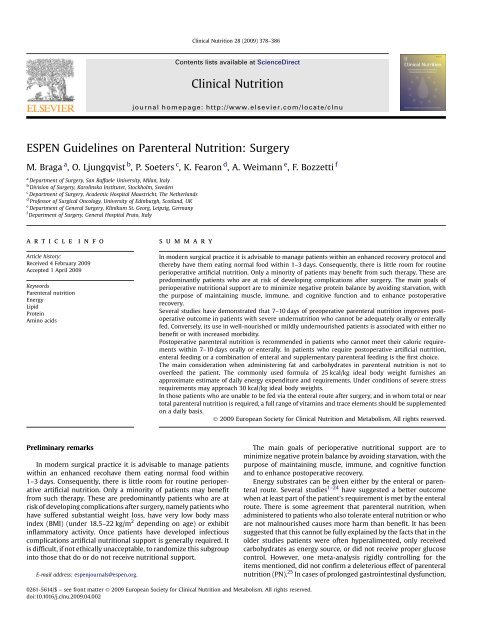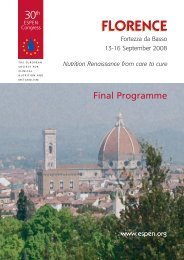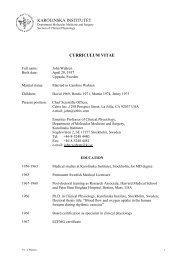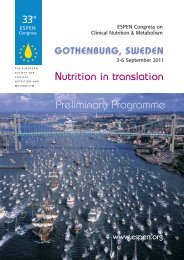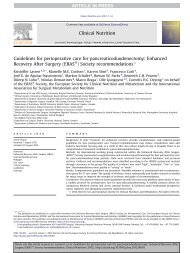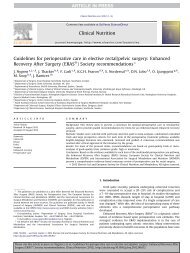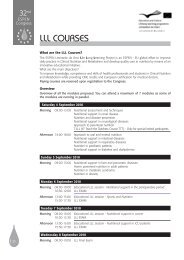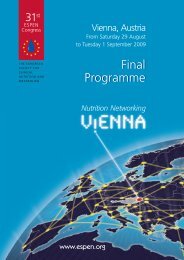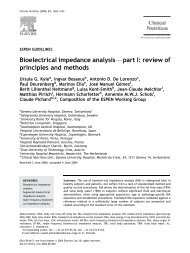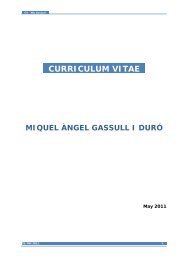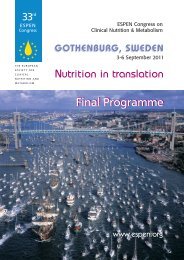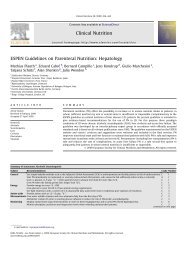ESPEN Guidelines on Parenteral Nutrition: Surgery
ESPEN Guidelines on Parenteral Nutrition: Surgery
ESPEN Guidelines on Parenteral Nutrition: Surgery
Create successful ePaper yourself
Turn your PDF publications into a flip-book with our unique Google optimized e-Paper software.
<str<strong>on</strong>g>ESPEN</str<strong>on</strong>g> <str<strong>on</strong>g>Guidelines</str<strong>on</strong>g> <strong>on</strong> <strong>Parenteral</strong> Nutriti<strong>on</strong>: <strong>Surgery</strong><br />
M. Braga a , O. Ljungqvist b , P. Soeters c , K. Fear<strong>on</strong> d , A. Weimann e , F. Bozzetti f<br />
a Department of <strong>Surgery</strong>, San Raffaele University, Milan, Italy<br />
b Divisi<strong>on</strong> of <strong>Surgery</strong>, Karolinska Institutet, Stockholm, Sweden<br />
c Department of <strong>Surgery</strong>, Academic Hospital Maastricht, The Netherlands<br />
d Professor of Surgical Oncology, University of Edinburgh, Scotland, UK<br />
e Department of General <strong>Surgery</strong>, Klinikum St. Georg, Leipzig, Germany<br />
f Department of <strong>Surgery</strong>, General Hospital Prato, Italy<br />
article info<br />
Article history:<br />
Received 4 February 2009<br />
Accepted 1 April 2009<br />
Keywords<br />
<strong>Parenteral</strong> nutriti<strong>on</strong><br />
Energy<br />
Lipid<br />
Protein<br />
Amino acids<br />
Preliminary remarks<br />
summary<br />
In modern surgical practice it is advisable to manage patients<br />
within an enhanced recohave them eating normal food within<br />
1–3 days. C<strong>on</strong>sequently, there is little room for routine perioperative<br />
artificial nutriti<strong>on</strong>. Only a minority of patients may benefit<br />
from such therapy. These are predominantly patients who are at<br />
risk of developing complicati<strong>on</strong>s after surgery, namely patients who<br />
have suffered substantial weight loss, have very low body mass<br />
index (BMI) (under 18.5–22 kg/m 2 depending <strong>on</strong> age) or exhibit<br />
inflammatory activity. Once patients have developed infectious<br />
complicati<strong>on</strong>s artificial nutriti<strong>on</strong>al support is generally required. It<br />
is difficult, if not ethically unacceptable, to randomize this subgroup<br />
into those that do or do not receive nutriti<strong>on</strong>al support.<br />
E-mail address: espenjournals@espen.org.<br />
Clinical Nutriti<strong>on</strong> 28 (2009) 378–386<br />
C<strong>on</strong>tents lists available at ScienceDirect<br />
Clinical Nutriti<strong>on</strong><br />
journal homepage: http://www.elsevier.com/locate/clnu<br />
In modern surgical practice it is advisable to manage patients within an enhanced recovery protocol and<br />
thereby have them eating normal food within 1–3 days. C<strong>on</strong>sequently, there is little room for routine<br />
perioperative artificial nutriti<strong>on</strong>. Only a minority of patients may benefit from such therapy. These are<br />
predominantly patients who are at risk of developing complicati<strong>on</strong>s after surgery. The main goals of<br />
perioperative nutriti<strong>on</strong>al support are to minimize negative protein balance by avoiding starvati<strong>on</strong>, with<br />
the purpose of maintaining muscle, immune, and cognitive functi<strong>on</strong> and to enhance postoperative<br />
recovery.<br />
Several studies have dem<strong>on</strong>strated that 7–10 days of preoperative parenteral nutriti<strong>on</strong> improves postoperative<br />
outcome in patients with severe undernutriti<strong>on</strong> who cannot be adequately orally or enterally<br />
fed. C<strong>on</strong>versely, its use in well-nourished or mildly undernourished patients is associated with either no<br />
benefit or with increased morbidity.<br />
Postoperative parenteral nutriti<strong>on</strong> is recommended in patients who cannot meet their caloric requirements<br />
within 7–10 days orally or enterally. In patients who require postoperative artificial nutriti<strong>on</strong>,<br />
enteral feeding or a combinati<strong>on</strong> of enteral and supplementary parenteral feeding is the first choice.<br />
The main c<strong>on</strong>siderati<strong>on</strong> when administering fat and carbohydrates in parenteral nutriti<strong>on</strong> is not to<br />
overfeed the patient. The comm<strong>on</strong>ly used formula of 25 kcal/kg ideal body weight furnishes an<br />
approximate estimate of daily energy expenditure and requirements. Under c<strong>on</strong>diti<strong>on</strong>s of severe stress<br />
requirements may approach 30 kcal/kg ideal body weights.<br />
In those patients who are unable to be fed via the enteral route after surgery, and in whom total or near<br />
total parenteral nutriti<strong>on</strong> is required, a full range of vitamins and trace elements should be supplemented<br />
<strong>on</strong> a daily basis.<br />
Ó 2009 European Society for Clinical Nutriti<strong>on</strong> and Metabolism. All rights reserved.<br />
0261-5614/$ – see fr<strong>on</strong>t matter Ó 2009 European Society for Clinical Nutriti<strong>on</strong> and Metabolism. All rights reserved.<br />
doi:10.1016/j.clnu.2009.04.002<br />
The main goals of perioperative nutriti<strong>on</strong>al support are to<br />
minimize negative protein balance by avoiding starvati<strong>on</strong>, with the<br />
purpose of maintaining muscle, immune, and cognitive functi<strong>on</strong><br />
and to enhance postoperative recovery.<br />
Energy substrates can be given either by the enteral or parenteral<br />
route. Several studies 1–24 have suggested a better outcome<br />
when at least part of the patient’s requirement is met by the enteral<br />
route. There is some agreement that parenteral nutriti<strong>on</strong>, when<br />
administered to patients who also tolerate enteral nutriti<strong>on</strong> or who<br />
are not malnourished causes more harm than benefit. It has been<br />
suggested that this cannot be fully explained by the facts that in the<br />
older studies patients were often hyperalimented, <strong>on</strong>ly received<br />
carbohydrates as energy source, or did not receive proper glucose<br />
c<strong>on</strong>trol. However, <strong>on</strong>e meta-analysis rigidly c<strong>on</strong>trolling for the<br />
items menti<strong>on</strong>ed, did not c<strong>on</strong>firm a deleterious effect of parenteral<br />
nutriti<strong>on</strong> (PN). 25 In cases of prol<strong>on</strong>ged gastrointestinal dysfuncti<strong>on</strong>,
Summary of statements: <strong>Surgery</strong><br />
Subject Recommendati<strong>on</strong>s Grade Number<br />
Indicati<strong>on</strong>s Preoperative fasting from midnight is unnecessary in most patients A Preliminary remarks<br />
Interrupti<strong>on</strong> of nutriti<strong>on</strong>al intake is unnecessary after surgery in most patients A Preliminary remarks<br />
Applicati<strong>on</strong> Preoperative parenteral nutriti<strong>on</strong> is indicated in severely undernourished patients who cannot be adequately orally<br />
or enterally fed<br />
A 1<br />
Postoperative parenteral nutriti<strong>on</strong> is beneficial in undernourished patients in whom enteral nutriti<strong>on</strong> is not feasible<br />
or not tolerated<br />
A 2<br />
Postoperative parenteral nutriti<strong>on</strong> is beneficial in patients with postoperative complicati<strong>on</strong>s impairing gastrointestinal<br />
functi<strong>on</strong> who are unable to receive and absorb adequate amounts of oral/enteral feeding for at least 7 days<br />
A 2<br />
In patients who require postoperative artificial nutriti<strong>on</strong>, enteral feeding or a combinati<strong>on</strong> of enteral and supplementary<br />
parenteral feeding is the first choice<br />
A 2<br />
Combinati<strong>on</strong>s of enteral and parenteral nutriti<strong>on</strong> should be c<strong>on</strong>sidered in patients in whom there is an indicati<strong>on</strong> for<br />
nutriti<strong>on</strong>al support and in whom >60% of energy needs cannot be met via the enteral route, e.g. in high output<br />
enterocutaneous fistulae or in patients in whom partly obstructing benign or malignant gastro-intestinal lesi<strong>on</strong>s do not<br />
allow enteral refeeding. In completely obstructing lesi<strong>on</strong>s surgery should not be postp<strong>on</strong>ed because of the risk of<br />
aspirati<strong>on</strong> or severe bowel distensi<strong>on</strong> leading to perit<strong>on</strong>itis<br />
C 2<br />
In patients with prol<strong>on</strong>ged gastrointestinal failure parenteral nutriti<strong>on</strong> is life-saving C 2<br />
Preoperative carbohydrate loading using the oral route is recommended in most patients. In the rare patients who<br />
cannot eat or are not allowed to drink preoperatively for whatever reas<strong>on</strong>s the intravenous route can be used<br />
A 3<br />
Type of formula The comm<strong>on</strong>ly used formula of 25 kcal/kg ideal body weight furnishes an approximate estimate of daily energy<br />
expenditure and requirements. Under c<strong>on</strong>diti<strong>on</strong>s of severe stress requirements may approach 30 kcal/kg ideal<br />
body weight<br />
B 4<br />
In illness/stressed c<strong>on</strong>diti<strong>on</strong>s a daily nitrogen delivery equivalent to a protein intake of 1.5 g/kg ideal body weight<br />
(or approximately 20% of total energy requirements) is generally effective to limit nitrogen losses<br />
B 4<br />
The Protein:Fat:Glucose caloric ratio should approximate to 20:30:50% C 4<br />
At present, there is a tendency to increase the glucose:fat calorie ratio from 50:50 to 60:40 or even 70:30 of the<br />
n<strong>on</strong>-protein calories, due to the problems encountered regarding hyperlipidemia and fatty liver, which is sometimes<br />
accompanied by cholestasis and in some patients may progress to n<strong>on</strong>-alcoholic steatohepatitis<br />
C 5<br />
Optimal nitrogen sparing has been shown to be achieved when all comp<strong>on</strong>ents of the parenteral nutriti<strong>on</strong> mix are<br />
administered simultaneously over 24 hours<br />
A 6<br />
Individualized nutriti<strong>on</strong> is often unnecessary in patients without serious co-morbidity C 7<br />
The optimal parenteral nutriti<strong>on</strong> regimen for critically ill surgical patients should probably include supplemental n-3<br />
fatty acids. The evidence-base for such recommendati<strong>on</strong>s requires further input from prospective randomised trials<br />
C 8<br />
In well-nourished patients who recover oral or enteral nutriti<strong>on</strong> by postoperative day 5 there is a little evidence that<br />
intravenous supplementati<strong>on</strong> of vitamins and trace elements is required<br />
C 9<br />
After surgery, in those patients who are unable to be fed via the enteral route, and in whom total or near total parenteral<br />
nutriti<strong>on</strong> is required, a full range of vitamins and trace elements should be supplemented <strong>on</strong> a daily basis<br />
C 9<br />
Weaning from parenteral nutriti<strong>on</strong> is not necessary A 10<br />
PN should be given until enteral functi<strong>on</strong> returns. The most<br />
important situati<strong>on</strong>s where enteral nutriti<strong>on</strong> is c<strong>on</strong>traindicated<br />
(thereby suggesting mandatory total parenteral nutriti<strong>on</strong>), are<br />
intestinal obstructi<strong>on</strong>, malabsorpti<strong>on</strong>, multiple fistulas with high<br />
output, intestinal ischemia, severe shock with impaired splanchnic<br />
perfusi<strong>on</strong>, and fulminant sepsis. 24<br />
To devise a nutriti<strong>on</strong>al support regimen for patients undergoing<br />
surgery, the basic changes in body metabolism that occur as a result<br />
of injury should be understood. In additi<strong>on</strong>, recent studies have<br />
shown that not <strong>on</strong>ly surgery itself influences the resp<strong>on</strong>se to<br />
nutriti<strong>on</strong>al support, but also many of the perioperative routine<br />
practices have a major impact <strong>on</strong> how well nutriti<strong>on</strong>al support is<br />
tolerated by the postoperative patient. 26<br />
<strong>Surgery</strong>, like any injury to the body, elicits a series of reacti<strong>on</strong>s<br />
including release of stress horm<strong>on</strong>es and inflammatory mediators.<br />
This release of mediators to the circulati<strong>on</strong> has a major impact <strong>on</strong><br />
body metabolism. They cause catabolism of glycogen, fat and<br />
protein with release of glucose, free fatty acids and amino acids into<br />
the circulati<strong>on</strong>, so that substrates are in part diverted from the<br />
purposes they serve in the n<strong>on</strong>-stressed state (i.e. physical activity)<br />
to the task of raising an adequate healing resp<strong>on</strong>se. For optimal<br />
rehabilitati<strong>on</strong> and wound healing, the body needs to be well<br />
nourished to mobilise adequate substrates, largely derived from<br />
muscle and adipose tissue, with nutriti<strong>on</strong>al support to allow<br />
synthesis of acute phase proteins, white cells, fibroblasts, collagen<br />
and other tissue comp<strong>on</strong>ents of the wounded area.<br />
Recent studies have shown that measures to reduce the stress of<br />
surgery can minimize postoperative insulin resistance, possibly<br />
improving the ability to tolerate normal nutriti<strong>on</strong>, but also allowing<br />
M. Braga et al. / Clinical Nutriti<strong>on</strong> 28 (2009) 378–386 379<br />
patients to recover faster, even after major surgical operati<strong>on</strong>s. The<br />
effects <strong>on</strong> morbidity and mortality still need to be studied. Such<br />
programmes for enhanced recovery after surgery 26<br />
involve<br />
multiple comp<strong>on</strong>ents that combine to minimize stress and to<br />
facilitate the return of functi<strong>on</strong>. These include preoperative preparati<strong>on</strong><br />
and medicati<strong>on</strong>, fluid balance, anaesthesia and postoperative<br />
analgesia regimens, perioperative nutriti<strong>on</strong>, and<br />
mobilizati<strong>on</strong>. 26<br />
Traditi<strong>on</strong>ally, many patients undergoing major gastrointestinal<br />
resecti<strong>on</strong>s receive large volumes of crystalloids intravenously<br />
during and after surgery. It was suggested that fluids and electrolytes<br />
were given in excess, resulting in substantial weight gain and<br />
oedema. It was also suggested that this overload was a major cause<br />
of postoperative ileus and delayed gastric emptying. 27–29 When<br />
fluids were restricted to the amount needed to maintain salt and<br />
water balance, gastric emptying returned so<strong>on</strong>er and patients were<br />
capable of tolerating normal food and had bowel movements<br />
several days earlier than those in positive balance. However, this<br />
claim has not been c<strong>on</strong>sistently supported by later studies. 26,30 The<br />
adverse effects of opioids used for pain relief can be avoided or<br />
substantially minimized by applying epidural analgesia in combinati<strong>on</strong><br />
with general anaesthesia. This especially improves cognitive<br />
functi<strong>on</strong> and bowel peristalsis.<br />
In recent years the traditi<strong>on</strong>al guidelines to fast patients overnight<br />
before elective surgery have been aband<strong>on</strong>ed. The traditi<strong>on</strong>al<br />
routine was not based <strong>on</strong> solid evidence, 31 while the evidence<br />
showing benefits and no harm when free intake of clear fluids was<br />
allowed until 2 h before anaesthesia was substantially str<strong>on</strong>ger. 32<br />
C<strong>on</strong>sequently, many anaesthesiology societies have changed their
380<br />
guidelines regarding fasting. 33 This change in guidelines was<br />
prompted by the absence of evidence that fasting reduced the risks<br />
of aspirati<strong>on</strong>. Allowing patients to drink also relieves the feeling of<br />
thirst that many patients experience before surgery.<br />
During the past decade, the metabolic effects of undergoing<br />
surgery in an overnight fasted state have been studied extensively<br />
and compared with the fed state. 34 The fed state may be induced<br />
prior to elective surgery by providing a carbohydrate load sufficiently<br />
large to elicit an insulin resp<strong>on</strong>se similar to that occurring<br />
after a normal meal. Insulin sensitivity is increased when this<br />
treatment is given before the <strong>on</strong>set of the stress of the surgical<br />
trauma. This change in metabolism up<strong>on</strong> entering surgery has been<br />
shown to have several effects <strong>on</strong> the resp<strong>on</strong>se to the operati<strong>on</strong>.<br />
Studies have reported positive effects in the postoperative recovery<br />
period such as improved protein balance, 35 improved preservati<strong>on</strong><br />
of lean body mass 36 and muscle strength 37 and reduced length of<br />
hospital stay after the operati<strong>on</strong>. 38,39<br />
In c<strong>on</strong>trast with elective surgery where the emphasis is <strong>on</strong> early<br />
return to oral intake, much progress has been made during the last<br />
20 years c<strong>on</strong>cerning the optimal design of PN to enhance recovery<br />
from critical illness. Firstly, it has been recognised that both the quality<br />
and quantity of lipid supplied may influence organ functi<strong>on</strong>, particularly<br />
that of the liver, and immune system. 40 This is especially relevant<br />
in patients that are critically ill for protracted periods of time. Sec<strong>on</strong>dly,<br />
theimportanceandthedangersofhyperglycaemiaduetoinsulin<br />
resistance have been reported. 41 However, the initial enthusiasm for<br />
tight glucose c<strong>on</strong>trol has been tempered by recognising the difficulty<br />
of maintaining low glucose levels without inducing periods of hypoglycaemia.<br />
Although c<strong>on</strong>vincing data shows that tight glucose c<strong>on</strong>trol<br />
is of clinical benefit (fewer infectious episodes and lower mortality) in<br />
patients undergoing cardiovascular surgery, its clinical applicability at<br />
present appears <strong>on</strong>ly to be advantageous in intensive care settings<br />
where this tight c<strong>on</strong>trol can be rigidly maintained. 42 Another modificati<strong>on</strong><br />
of the PN regimen that may be of benefit c<strong>on</strong>sists of the<br />
additi<strong>on</strong> of extra glutamine and arginine (see Secti<strong>on</strong> 9.2).<br />
1. When is preoperative PN indicated?<br />
In severely undernourished patients who cannot be<br />
adequately orally or enterally fed (Grade A).<br />
Comments: The influence of nutriti<strong>on</strong>al status <strong>on</strong> postoperative<br />
morbidity and mortality has been well documented in both retrospective<br />
43–46 and prospective studies. 47–59 Inadequate oral intake<br />
for more than 14 days is associated with a higher mortality. 60 Two<br />
multivariate analyses have shown, for hospitalised patients in<br />
general and for those undergoing surgery for cancer in particular,<br />
that undernutriti<strong>on</strong> is an independent risk factor for the incidence<br />
of infectious complicati<strong>on</strong>s, as well as increased mortality, length of<br />
hospital stay, and costs. 61<br />
Undernutriti<strong>on</strong> frequently occurs in associati<strong>on</strong> with underlying<br />
disease (e.g. cancer) or with organ failure. 61–69 The risk of severe<br />
undernutriti<strong>on</strong> is c<strong>on</strong>sidered by the <str<strong>on</strong>g>ESPEN</str<strong>on</strong>g> working group to be<br />
present when at least <strong>on</strong>e of the following criteria is present:<br />
weight loss > 10–15% within 6 m<strong>on</strong>ths; BMI < 18 kg/m 2 ; subjective<br />
global assessment, Grade C; serum albumin < 30 g/L (with no<br />
evidence of hepatic or renal dysfuncti<strong>on</strong>).<br />
On the basis of several reports in the literature and a large<br />
cohort study, 70 the working group c<strong>on</strong>siders hypoalbuminaemia to<br />
reflect inflammatory activity and as such to be a risk indicator of<br />
postoperative infectious complicati<strong>on</strong>s and mortality rather than of<br />
nutriti<strong>on</strong>al status itself.<br />
Several studies have dem<strong>on</strong>strated that 7–10 days of preoperative<br />
parenteral nutriti<strong>on</strong> improves postoperative outcome in<br />
patients with severe undernutriti<strong>on</strong>. 10,71–73 C<strong>on</strong>versely, its use in<br />
M. Braga et al. / Clinical Nutriti<strong>on</strong> 28 (2009) 378–386<br />
well-nourished or mildly undernourished patients is associated<br />
with either no benefit or with increased morbidity. 71 Moreover,<br />
preoperative parenteral nutriti<strong>on</strong> is costly and can generally <strong>on</strong>ly be<br />
applied in the hospital setting, prol<strong>on</strong>ging length of stay in the<br />
hospital. Significant improvements in postoperative outcome have<br />
been reported by using preoperative oral nutriti<strong>on</strong>al supplements<br />
enriched with specific immune-modulating substrates regardless<br />
of baseline nutriti<strong>on</strong>al status. 74–82 This approach is cheaper than PN<br />
and patients can be treated at home. It requires extra attenti<strong>on</strong> to<br />
ensure that oral supplements or nutriti<strong>on</strong>al drinks are actually<br />
taken by the patients.<br />
2. When is postoperative PN indicated?<br />
<strong>Parenteral</strong> nutriti<strong>on</strong> is beneficial in the following circumstances:<br />
in undernourished patients in whom enteral nutriti<strong>on</strong> is<br />
not feasible or not tolerated (Grade A); in patients with postoperative<br />
complicati<strong>on</strong>s impairing gastrointestinal functi<strong>on</strong> who<br />
are unable to receive and absorb adequate amounts of oral/<br />
enteral feeding for at least 7 days (Grade A).<br />
In patients who require postoperative artificial nutriti<strong>on</strong>,<br />
enteral feeding or a combinati<strong>on</strong> of enteral and supplementary<br />
parenteral feeding is the first choice (Grade A).<br />
Combinati<strong>on</strong>s of enteral and parenteral nutriti<strong>on</strong> should be<br />
c<strong>on</strong>sidered in patients in whom there is an indicati<strong>on</strong> for nutriti<strong>on</strong>al<br />
support and in whom >60% of energy needs cannot be met via the<br />
enteral route, e.g. in high output enterocutaneous fistulae (Grade C)<br />
or in patients in whom partly obstructing benign or malignant<br />
gastrointestinal lesi<strong>on</strong>s do not allow enteral refeeding (Grade C).<br />
In completely obstructing lesi<strong>on</strong>s surgery should not be postp<strong>on</strong>ed<br />
because of the risk of aspirati<strong>on</strong> or severe bowel distensi<strong>on</strong><br />
leading to perit<strong>on</strong>itis (Grade C).<br />
In patients with prol<strong>on</strong>ged gastrointestinal failure PN is lifesaving<br />
(Grade C).<br />
Comments: Patients having major surgery for head-neck,<br />
and abdominal cancer (larynx, pharynx or oesophageal resecti<strong>on</strong>,<br />
gastrectomy, pancreatoduodenectomy) often exhibit nutriti<strong>on</strong>al<br />
depleti<strong>on</strong> before surgery 47,51,54–56,63,65,67,68 and run a higher risk of<br />
developing septic complicati<strong>on</strong>s. 47,51,54–56,68 Postoperatively, oral<br />
intake is often delayed due to swelling, obstructi<strong>on</strong>, impaired gastric<br />
emptying or paralytic ileus, making it difficult to meet nutriti<strong>on</strong>al<br />
requirements. In these patients surge<strong>on</strong>s should c<strong>on</strong>sider the<br />
placement of a feeding jejunostomy at the time of surgery. Nutriti<strong>on</strong>al<br />
support reduces morbidity and immune-modulating formulae<br />
appear to be especially efficacious. 81 Morbidity, length of hospital<br />
stay, and mortality are c<strong>on</strong>sidered principal outcome parameters<br />
when evaluating the benefits of nutriti<strong>on</strong>al support. After discharge<br />
from the hospital or when palliati<strong>on</strong> is the main aim of nutriti<strong>on</strong>al<br />
support, improvement in nutriti<strong>on</strong>al status and in quality of life is<br />
the main evaluati<strong>on</strong> criteria. 83–93<br />
Other current guidelines recommend postoperative artificial<br />
nutriti<strong>on</strong> for patients who cannot meet their caloric requirements<br />
within 7–10 days. 24,94 In patients who require postoperative artificial<br />
nutriti<strong>on</strong>, enteral feeding or a combinati<strong>on</strong> of enteral and<br />
supplementary parenteral feeding is the first choice. The routine<br />
use of postoperative parenteral nutriti<strong>on</strong> has not proved useful<br />
either in well-nourished patients or in those with adequate oral<br />
intake within a week after surgery. 24,94<br />
New anaesthetic techniques for pain c<strong>on</strong>trol and the development<br />
of early postoperative recovery protocols allow the majority<br />
of patients to return to oral feeding very shortly after surgery.<br />
C<strong>on</strong>sequently, the number of patients requiring postoperative<br />
nutriti<strong>on</strong>al support is progressively declining.
3. Is preoperative metabolic preparati<strong>on</strong> of elective patients<br />
using carbohydrate treatment useful?<br />
For most patients preoperative carbohydrate loading using the<br />
oral route is recommended (Grade A). In the rare patients who<br />
cannot eat or are not allowed to drink preoperatively for whatever<br />
reas<strong>on</strong>s the intravenous route can be used.<br />
Comments: For patients who qualify for free intake of fluids<br />
according to modern guidelines, carbohydrate drinks that have been<br />
tested properly can be safely used. This treatment has been shown to<br />
minimise insulin resistance, postoperative hyperglycaemia, loss of<br />
protein, lean body mass and muscle functi<strong>on</strong>, reduce anxiety and<br />
postoperative nausea and vomiting in general and orthopaedic<br />
surgery, and to be cardioprotective in cardiac surgery. This is therefore<br />
the primary mode of treatment to be recommended to most patients.<br />
For those who cannot eat or are not allowed to drink preoperatively for<br />
whatever reas<strong>on</strong>, a glucose infusi<strong>on</strong> at a rate of 5 mg/kg per min will<br />
have very similar effects, not <strong>on</strong>ly with regard to the main metabolic<br />
outcome variable – insulin resistance – but also to protein metabolism<br />
35 and cardiac protecti<strong>on</strong>. 95–98<br />
The overwhelming majority of the data available in this field is<br />
based <strong>on</strong> studies in n<strong>on</strong>-diabetic patients, with <strong>on</strong>ly <strong>on</strong>e excepti<strong>on</strong>. 95<br />
When given orally, the drink is a mixture of complexcarbohydrates,i.e.<br />
maltodextrins, in a c<strong>on</strong>centrati<strong>on</strong> of about 12.5%. 99 When given<br />
intravenously, carbohydrate loading is achieved using a glucose<br />
soluti<strong>on</strong> with a higher c<strong>on</strong>centrati<strong>on</strong>, usually 20%, to administer<br />
a sufficient quantity in a low volume to ensure a sufficient insulin<br />
resp<strong>on</strong>se. 100 Studies where i.v. glucose loading al<strong>on</strong>e or in combinati<strong>on</strong><br />
with other nutrients or insulin have been reviewed in more detail in<br />
recent years. 34,38,101–108 It is uncertain to what extent the additi<strong>on</strong> of<br />
other substrates or insulin adds to the effects of glucose al<strong>on</strong>e. In the<br />
healthy n<strong>on</strong>-diabetic patient with normal glucose tolerance, glucose<br />
administrati<strong>on</strong> will induce insulin release and this will also ensure<br />
glucose c<strong>on</strong>trol when greater quantities of glucose are infused.<br />
Changing metabolism using enteral or intravenous carbohydrate<br />
treatment before elective surgery has therefore been shown to have<br />
several beneficial effects including less pr<strong>on</strong>ounced stress resp<strong>on</strong>se,<br />
heightened insulin sensitivity, and the opportunity to allow earlier<br />
postoperative feeding without the development of hyperglycaemia. 109<br />
4. What are the energy and protein requirements in the<br />
perioperative period?<br />
The comm<strong>on</strong>ly used formula of 25 kcal/kg ideal body weight<br />
furnishes an approximate estimate of daily energy expenditure and<br />
requirements (Grade B). Under c<strong>on</strong>diti<strong>on</strong>s of severe stress requirements<br />
may approach 30 kcal/kg ideal body weight (Grade B).<br />
In illness/stressed c<strong>on</strong>diti<strong>on</strong>s a daily nitrogen delivery equivalent<br />
to a protein intake of 1.5 g/kg ideal body weight (or<br />
approximately 20% of total energy requirements) is generally<br />
effective to limit nitrogen losses (Grade B). The protein:fat:glucose<br />
caloric ratio should approximate to 20:30:50% (Grade C).<br />
Comments: Energy. In acute and chr<strong>on</strong>ic disease the resting<br />
metabolic rate is elevated above the values calculated from the<br />
Harris–Benedict equati<strong>on</strong>s in both men and women. The degree of<br />
hypermetabolism differs but is <strong>on</strong> average not more than 110–120%<br />
of predicted. 110–113 In individual patients this value may be<br />
increased substantially to 160–180% for short periods. Examples<br />
include patients with open burn wounds, severe acute sepsis and<br />
those with head trauma. 111,114–116<br />
The figure of 25 kcal/kg ideal body weight may severely overestimate<br />
daily energy expenditure in obese patients. 112 In view of<br />
M. Braga et al. / Clinical Nutriti<strong>on</strong> 28 (2009) 378–386 381<br />
the increased prevalence of obesity it is therefore wise to c<strong>on</strong>sider<br />
ideal body weight when calculating energy requirements and to<br />
use calorimetry whenever possible.<br />
The main c<strong>on</strong>siderati<strong>on</strong> when administering fat and carbohydrates<br />
in parenteral nutriti<strong>on</strong> is not to overfeed the patient. 113,117,118<br />
Hyperalimentati<strong>on</strong> is known to increase energy expenditure,<br />
oxygen c<strong>on</strong>sumpti<strong>on</strong> and carb<strong>on</strong> dioxide producti<strong>on</strong>. 119,120 Especially<br />
in frail patients with low cardiac, ventilatory and respiratory<br />
reserve these effects may be deleterious. 121 In additi<strong>on</strong>, hyperalimentati<strong>on</strong><br />
may induce fatty liver and lead to hypertriglyceridaemia<br />
with harmful effects <strong>on</strong> immune functi<strong>on</strong>. 40 Patients <strong>on</strong> l<strong>on</strong>g term<br />
parenteral nutriti<strong>on</strong> are especially pr<strong>on</strong>e to develop fatty liver and<br />
cholestasis. 122 Several factors may be held resp<strong>on</strong>sible. Sepsis, but<br />
also milder chr<strong>on</strong>ic inflammatory states interfere with the hydrolysis<br />
of triglycerides leading to hypertriglyceridaemia and fatty<br />
liver. Patients requiring l<strong>on</strong>g term parenteral nutriti<strong>on</strong> often have<br />
a short bowel leading to disturbances in enterohepatic cycling of<br />
bile acids. Bile acid loss in the stools diminishes the size of the bile<br />
acid pool, which makes the liver more vulnerable for toxic influences.<br />
Bacterial overgrowth may lead to the formati<strong>on</strong> of sec<strong>on</strong>dary<br />
bile acids which have hepatotoxic effects, leading to cholestasis.<br />
Many patients now have underlying or c<strong>on</strong>comitant metabolic<br />
syndrome – an additi<strong>on</strong>al factor leading to disturbed fat clearance.<br />
A proporti<strong>on</strong> of patients with fatty liver go <strong>on</strong> to develop a n<strong>on</strong>infective<br />
hepatitis – steatohepatitis – which may ultimately progress<br />
to liver cirrhosis and liver failure. The lipid emulsi<strong>on</strong> itself can<br />
aggravate hypertriglyceridaemia and liver steatosis. 123<br />
C<strong>on</strong>versely, a calculated intake of 25 kcal/kg per 24 h may underestimate<br />
requirements in patients with very low body weights due to<br />
very low fat mass. Although there are no data in the literature suggesting<br />
that slight underfeeding has harmful effects, in truly cachectic<br />
patients careful m<strong>on</strong>itoring of body weight and vital signs is necessary<br />
to assessthe resp<strong>on</strong>se to nutriti<strong>on</strong>al support and to allow such patients<br />
to gain weight without causing signs of hypermetabolism due to<br />
hyperalimentati<strong>on</strong>. In such cachectic patients care should be taken to<br />
increase the amount of calories and protein slowly and to take care<br />
to prevent the refeeding syndrome. In extreme cachexia indirect<br />
calorimetry, if available, may help to assess energy requirements.<br />
Protein/amino acids<br />
Amino acid requirements in parenteral nutriti<strong>on</strong> are higher<br />
when the patient is stressed/traumatized/infected than in the n<strong>on</strong>stressed<br />
state 124–126 as a c<strong>on</strong>sequence of the stressed body breaking<br />
down more protein and more essential amino acids than when<br />
n<strong>on</strong>-stressed. One reas<strong>on</strong> why this is a useful arrangement is that it<br />
allows the immune system to increase its activity. For this purpose,<br />
more glutamine and alanine are required. They are produced by<br />
transaminati<strong>on</strong> of carb<strong>on</strong> skelet<strong>on</strong>s with amino groups from the<br />
branched-chain amino acids (BCAA) which are irreversibly<br />
degraded in this process and cannot be re-utilized for renewed<br />
protein synthesis. It is well established that muscle protein degradati<strong>on</strong><br />
is regulated by pro-inflammatory modulators like tumour<br />
necrosis factor-alpha, interleukin-6 and others, and therefore<br />
cannot be reversed by nutriti<strong>on</strong>. 127 The value of nutriti<strong>on</strong>al support<br />
comes instead from its support of protein synthesis in muscle and<br />
most importantly in the liver, yielding acute phase proteins, and in<br />
the immune system, yielding white cells crucial in the resp<strong>on</strong>se to<br />
trauma or disease, and thereby limits net whole body protein<br />
loss. 124,128 As for energy requirements protein/nitrogen requirements<br />
should be calculated <strong>on</strong> the basis of ideal body weight or<br />
adjusted body weight. There are no c<strong>on</strong>vincing data suggesting that<br />
overfeeding nitrogen has deleterious effects as l<strong>on</strong>g as patients are<br />
not generally hyperalimented, 113 but provisi<strong>on</strong> of excess amino<br />
acids is certainly wasteful in cost terms. Whether to include the
382<br />
amino acid in the total count of the calories depends <strong>on</strong> the<br />
perspective of the physician. The classic teaching of the physiology<br />
of nutriti<strong>on</strong> states that having determined the total energy<br />
requirement of a healthy individual, the caloric needs are met by<br />
giving carbohydrates, fats and proteins in well-defined percentages.<br />
However, the assumpti<strong>on</strong> behind this statement is that the<br />
calorie:nitrogen ratio is always the same in healthy and ill c<strong>on</strong>diti<strong>on</strong>s.<br />
This is not true in postoperative or many post-injury settings<br />
where protein requirements far exceed the increase in energy<br />
expenditure. On the other hand, there is increasing awareness of<br />
the adverse c<strong>on</strong>sequences of overfeeding the patients in critical<br />
c<strong>on</strong>diti<strong>on</strong>s, hence the careful calculati<strong>on</strong> of the calories administered<br />
to the patient has to take into account not <strong>on</strong>ly carbohydrates<br />
and fats but also the amino acids, even if their c<strong>on</strong>tributi<strong>on</strong> to the<br />
total calorie load is relatively small.<br />
5. Which is the optimal glucose:lipid ratio?<br />
At present, there is a tendency to increase the glucose:fat<br />
calorie ratio from 50:50 to 60:40 or even 70:30 of the n<strong>on</strong>-protein<br />
calories, due to the problems encountered regarding hyperlipidaemia<br />
and fatty liver, which is sometimes accompanied by<br />
cholestasis and in some patients may progress to n<strong>on</strong>-alcoholic<br />
steatohepatitis (Grade C).<br />
Comments: Exactly what disadvantages derive from fatty liver<br />
and hypertriglyceridaemia are unknown. In the vascular literature<br />
it is firmly established that hypertriglyceridaemia is a risk factor for<br />
the development of arteriosclerosis and acute infusi<strong>on</strong> of l<strong>on</strong>gchain<br />
triglyceride (LCT) c<strong>on</strong>taining lipid emulsi<strong>on</strong> diminishes the<br />
ability of the arterial vascular bed to relax. The main c<strong>on</strong>cern that<br />
these c<strong>on</strong>diti<strong>on</strong>s impair immune resp<strong>on</strong>se is not supported by<br />
a recent meta-analysis. 129 However, most experts recommend<br />
avoiding a triglyceride level greater than 5 mmol/dL, although hard<br />
data supporting this are lacking. When this level is reached it is<br />
recommended by many experts in the field to diminish the fat<br />
c<strong>on</strong>tent (especially n-6 poly-unsaturated fatty acids (PUFAs)) of the<br />
parenteral nutriti<strong>on</strong> or temporarily to withdraw fat. In this event<br />
the energy deficit should not be replaced by adding more glucose<br />
because this may exceed the patient’s oxidative capacity.<br />
6. Which is the optimal PN mixture?<br />
Optimal nitrogen sparing has been shown to be achieved when<br />
all comp<strong>on</strong>ents of the parenteral nutriti<strong>on</strong> mix are administered<br />
simultaneously over 24 h (Grade A).<br />
Comments: Three-in-<strong>on</strong>e mixtures are c<strong>on</strong>venient and allow<br />
c<strong>on</strong>tinuous and stable administrati<strong>on</strong> of all necessary comp<strong>on</strong>ents.<br />
The importance and complexity of the mixing process however is<br />
underestimated and requires experience. The compositi<strong>on</strong> may<br />
influence emulsi<strong>on</strong> stability and particle size. These characteristics<br />
are difficult to assess and <strong>on</strong>ly in extreme situati<strong>on</strong>s will ‘‘oiling<br />
out’’ become visible. The recommendati<strong>on</strong>s of the manufacturers<br />
and of specialist pharmacy units should therefore be followed<br />
when mixing is performed in the regular hospital pharmacy. Mixing<br />
<strong>on</strong> the wards is to be str<strong>on</strong>gly discouraged. Commercially<br />
available ‘‘ready-made’’ nutriti<strong>on</strong> mixtures should be kept refrigerated<br />
as recommended and <strong>on</strong>ly mixed (by opening compartmentalized<br />
bags) just before administrati<strong>on</strong>.<br />
Endeavours to allow the cholecystokinin resp<strong>on</strong>se to occur, thus<br />
aiming to prevent biliary sludge forming in the gallbladder by<br />
disc<strong>on</strong>tinuati<strong>on</strong> of nutriti<strong>on</strong> during 8–10 h per 24 h (cycling<br />
feeding) have not been shown to be beneficial in the perioperative<br />
M. Braga et al. / Clinical Nutriti<strong>on</strong> 28 (2009) 378–386<br />
c<strong>on</strong>text. Such practices also tend to increase metabolic instability,<br />
specifically with regard to glucose homeostasis. Little research has<br />
been d<strong>on</strong>e regarding the tapering of nutriti<strong>on</strong> during the 24 h<br />
immediately surrounding the operati<strong>on</strong>. Generally the infusi<strong>on</strong> rate<br />
is reduced to half or less of requirements to minimize metabolic<br />
instability during and immediately after operati<strong>on</strong>. Recent data<br />
suggest that glucose homeostasis is achieved within 1 h after<br />
abruptly disc<strong>on</strong>tinuing parenteral nutriti<strong>on</strong>.<br />
7. Standard versus individualized nutriti<strong>on</strong>?<br />
Individualized nutriti<strong>on</strong> is often unnecessary in patients<br />
without serious co-morbidity (Grade C).<br />
Comments: There are a number of situati<strong>on</strong>s in which standardized<br />
nutriti<strong>on</strong>al support cannot be applied:<br />
- Patients who suffer from heart failure may benefit from more<br />
c<strong>on</strong>centrated nutriti<strong>on</strong>, in which requirements are fulfilled in<br />
a lower volume. These patients sometimes require a sodium<br />
restricted regimen.<br />
- Patients with chr<strong>on</strong>ic renal failure and oliguria often require<br />
a restricted sodium and potassium regimen in low total volume.<br />
Protein/nitrogen restricti<strong>on</strong> is generally not recommended,<br />
because it may aggravate the malnutriti<strong>on</strong> which is often<br />
accompanying chr<strong>on</strong>ic renal failure. 125,130,131 The quality of renal<br />
replacement therapy has improved to such a degree that nitrogenous<br />
waste can efficiently be cleared even when liberal amounts<br />
of amino acids are included in the nutriti<strong>on</strong>al regimen. 130<br />
- Patients with hepatic failure have in the past been treated with<br />
low protein diets. This is obsolete. 13 Very few patients will<br />
develop hepatic encephalopathy when receiving nutriti<strong>on</strong> with<br />
normal amounts of protein. In fact, restricti<strong>on</strong> induces a vicious<br />
circle by down-regulating enzymes in the urea cycle. Most<br />
patients therefore benefit from normal or even liberal amounts<br />
of protein/amino acids. 132 In parenteral nutriti<strong>on</strong> the inducti<strong>on</strong><br />
of encephalopathy by amino acids in the nutriti<strong>on</strong>al mixture is<br />
even rarer and daily amounts up to 1.2–1.5 g protein/kg ideal<br />
body weight may be safely administered. There is still some<br />
support for the claim that BCAA enriched parenteral nutriti<strong>on</strong><br />
is of benefit in liver patients and specifically those with<br />
impending or existing neurological signs. However, such<br />
patients should not undergo surgery if this can be prevented,<br />
because liver failure str<strong>on</strong>gly increases the risk of developing<br />
infectious complicati<strong>on</strong>s.<br />
- Patients with gut failure or high output fistulas may develop<br />
a multitude of metabolic and electrolyte disturbances, which<br />
make supplementati<strong>on</strong> with several comp<strong>on</strong>ents of the normal<br />
nutriti<strong>on</strong> mix necessary. Specifically trace elements, electrolytes<br />
(especially sodium and magnesium) and vitamins are pr<strong>on</strong>e to<br />
become deficient. Standardized nutriti<strong>on</strong> may sometimes still be<br />
possible but the mix should be supplemented as required.<br />
8. Should specific nutrients be added to standard PN to<br />
obtain a clinical benefit?<br />
The optimal PN regimen for critically ill surgical patients<br />
should probably include supplemental n-3 fatty acids (Grade C).<br />
The evidence-base for such recommendati<strong>on</strong>s requires further<br />
input from prospective randomised trials.<br />
Comments: Lipids. The inclusi<strong>on</strong> of a lipid emulsi<strong>on</strong> as part of<br />
the energy source in PN reduces the overall carbohydrate load and
osmolarity of the soluti<strong>on</strong> and this has generally been held to be<br />
good practice. However, replacing glucose-derived calories with<br />
lipid calories is not without metabolic effects. The standard lipid<br />
emulsi<strong>on</strong>s have for many years been soybean-based emulsi<strong>on</strong>s rich<br />
in n-6 PUFA. However, n-6 PUFAs tend to have a pro-inflammatory<br />
effect, and trials tend to show lower complicati<strong>on</strong> rates in patients<br />
receiving PN c<strong>on</strong>taining fewer of these fatty acids. 133<br />
In view of these c<strong>on</strong>siderati<strong>on</strong>s attempts have been made to<br />
reduce the l<strong>on</strong>g-chain PUFA c<strong>on</strong>tent without a net loss of lipid<br />
calories. This has been d<strong>on</strong>e by replacing part of the lipid by<br />
medium-chain triglycerides (MCT), by administering synthetic<br />
lipids which c<strong>on</strong>sist of a glycerol backb<strong>on</strong>e randomly esterified<br />
with MCT or LCT and which thus provide another route to the<br />
provisi<strong>on</strong> of LCT and MCT, or by a substantial replacement of PUFA<br />
by n-9 LCT (olive oil). All such emulsi<strong>on</strong>s c<strong>on</strong>tain lower amounts of<br />
n-6 fatty acids and appear to have fewer immunological effects. 134<br />
In comparis<strong>on</strong> to n-6 PUFAs, n-3 PUFAs have a relatively antiinflammatory<br />
effect and when included with gamma linolenic acid<br />
and given enterally in ICU, have been shown in prospective<br />
randomized trials to improve pulm<strong>on</strong>ary inflammati<strong>on</strong>, to shorten<br />
days <strong>on</strong> the ventilator and overall ICU stay. 135–137 When included in<br />
PN, n-3 fatty acids have been shown to blunt the physiological<br />
resp<strong>on</strong>se to endotoxin in healthy subjects. 138 In open label cohort<br />
studies, increasing dosage of n-3 PUFAs has been associated with<br />
reduced ICU stay following major abdominal surgery, 139 and in<br />
a randomised trial inclusi<strong>on</strong> of n-3 PUFAs in PN was associated with<br />
reduced overall hospital stay. 140 Thus, at present there is some<br />
evidence that inclusi<strong>on</strong> of n-3 fatty acids in PN may benefit organ<br />
functi<strong>on</strong> and reduce length of stay in patients undergoing major<br />
surgery or admitted to the surgical ICU. However, these trends will<br />
need to be substantiated in adequately powered randomised trials.<br />
Amino acids.: Many different modificati<strong>on</strong>s of the amino acid<br />
compositi<strong>on</strong> have been proposed for parenteral nutriti<strong>on</strong> of<br />
stressed patients. BCAA enrichment has been proposed for severely<br />
traumatized or diseased patients. Neither clear clinical benefit nor<br />
harmful effects have been reported.<br />
Glutamine and arginine are the two amino acids that have<br />
received significant evaluati<strong>on</strong> as potential modulators of clinical<br />
outcome in surgical patients receiving PN. To circumvent the<br />
problem that glutamine is unstable in soluti<strong>on</strong> and not very soluble,<br />
glutamine peptides have been c<strong>on</strong>structed with glycine and<br />
alanine. In stressed states the body ‘‘infuses itself’’ with an amino<br />
acid mixture which is richer in glutamine and alanine than the<br />
amino acid compositi<strong>on</strong> of the proteins that we eat normally.<br />
Glutamine has a major role as a substrate for the immune system<br />
and for the small bowel. Recent evidence also suggests it may act as<br />
a stress-signalling molecule and thus some of its benefits may be<br />
independent of its acti<strong>on</strong> as a metabolic fuel. Glutamine has been<br />
shown to aid preservati<strong>on</strong> of small bowel anatomy and functi<strong>on</strong> in<br />
patients following major surgery 141 and to preserve T-lymphocyte<br />
resp<strong>on</strong>siveness in similar patients. 142 A meta-analysis has shown that<br />
postoperative PN supplemented with glutamine dipeptide (20–40 g/<br />
24 h) improves nitrogen balance and short term outcome in patients<br />
who have underg<strong>on</strong>e abdominal surgery. 143 However, a recent multicentre<br />
trial carried out in 427 well-nourished cancer patients did not<br />
show any advantage <strong>on</strong> short term outcome in subjects receiving<br />
perioperative i.v. glutamine. 144 Surgical patients in ICU receiving<br />
glutamine enriched PN or EN have been shown in a few studies to have<br />
reduced mortality, lower infecti<strong>on</strong> rates and reduced organ failure.<br />
However, definitive evidence is still lacking and several major randomised<br />
studies are in progress. 145<br />
Arginine has also received c<strong>on</strong>siderable attenti<strong>on</strong>, because it is<br />
known to stimulate T-cell functi<strong>on</strong> and is a precursor of nitric oxide.<br />
Recent studies showed that arginine when given al<strong>on</strong>g with<br />
other immunomodulatory nutrients reduced the incidence of<br />
M. Braga et al. / Clinical Nutriti<strong>on</strong> 28 (2009) 378–386 383<br />
postoperative infecti<strong>on</strong>s and length of stay in cancer patients<br />
undergoing abdominal surgery. 146 The potentially beneficial effects<br />
in surgical patients of arginine, enterally given, cannot be dissected<br />
from the effects of u-3 fatty acids and RNA in these formulas. Nor is<br />
it certain that these results can be extrapolated to parenteral<br />
nutriti<strong>on</strong>. There is, however, c<strong>on</strong>troversy about the use of either<br />
enteral or parenteral arginine in critically ill septic patients 147 and<br />
further studies are awaited.<br />
9. Should vitamins/trace elements be used in<br />
perioperative PN?<br />
In well-nourished patients who recover oral or enteral nutriti<strong>on</strong><br />
by postoperative day 5 there is a little evidence that intravenous<br />
supplementati<strong>on</strong> of vitamins and trace elements is<br />
required (Grade C).<br />
In those patients after surgery who are unable to be fed via the<br />
enteral route, and in whom total or near total parenteral nutriti<strong>on</strong><br />
is required, a full range of vitamins and trace elements<br />
should be supplemented <strong>on</strong> a daily basis (Grade C).<br />
Comments: Short-term standard micr<strong>on</strong>utrient supplementati<strong>on</strong><br />
does not restore plasma antioxidant status after surgery. 148 It is<br />
possible that during surgical stress supra-normal amounts of ascorbate,<br />
alpha-tocopherol, and trace elements are required. While data<br />
from prospective randomized c<strong>on</strong>trolled trials support the supplementati<strong>on</strong><br />
of PN with vitamins and trace elements in critically ill<br />
patients (see <str<strong>on</strong>g>ESPEN</str<strong>on</strong>g> guidelines <strong>on</strong> PN in critical illness) no data exist for<br />
patients with an uncomplicated course, and nor are there studies in<br />
which the requirements for micr<strong>on</strong>utrients are investigated in<br />
malnourished patients compared to well-nourished patients.<br />
When early oral food intake/enteral nutriti<strong>on</strong> is combined with<br />
parenteral nutriti<strong>on</strong>, intravenous supplementati<strong>on</strong> of vitamins<br />
appears to be unnecessary. In the case of total parenteral nutriti<strong>on</strong>,<br />
a c<strong>on</strong>sensus exists that micr<strong>on</strong>utrients/antioxidants should be<br />
supplemented <strong>on</strong> a daily basis. 149–152 In accordance with the USA<br />
Food and Drug Administrati<strong>on</strong> (FDA) the recommendati<strong>on</strong>s for<br />
micr<strong>on</strong>utrients provisi<strong>on</strong> were recently updated 149,152 (see Table 1).<br />
Table 1<br />
Daily requirements for vitamins in adults when given parenterally (V1).<br />
Vitamins Requirement<br />
Thiamin (B1) 6 mg<br />
Riboflavin (B2) 3.6 mg<br />
Niacin (B3) 40 mg<br />
Folic acid 600 mg<br />
Panthotenic acid 15 mg<br />
Pyridoxine (B6) 6 mg<br />
Cyanocobalamin (B12) 5 mg<br />
Biotin 60 mg<br />
Ascorbic Acid (C) 200 mg<br />
Vitamin A 3300 IU<br />
Vitamin D 200 IU<br />
Vitamin E 10 IU<br />
Vitamin K 150 mg<br />
Daily requirements for trace elements in adults when given parenterally (V1)<br />
Trace element Standard intake<br />
Chromium 10–15 mg<br />
Copper 0.3–0.5 mg<br />
Ir<strong>on</strong> 1.0–1.2 mg<br />
Manganese 0.2–0.3 mg<br />
Selenium 20–60 mg<br />
Zinc 2.5–5 mg<br />
Molybdenum 20 mg<br />
Iodine 100 mg<br />
Fluoride 1 mg
384<br />
10. Is weaning from PN necessary?<br />
No (Grade A).<br />
Comments: From the popularisati<strong>on</strong> of PN by Dudrick until<br />
recently it has been recommended that PN is tapered prior to<br />
disc<strong>on</strong>tinuati<strong>on</strong> so as to prevent hypoglycaemia. However, it has<br />
been shown that even after prol<strong>on</strong>ged PN the beta-cells remain<br />
sensitive to changes in glucose levels and that adaptati<strong>on</strong> of glucose<br />
levels and insulin secreti<strong>on</strong> occur very quickly. 153<br />
Ad hoc studies have shown that after the abrupt disc<strong>on</strong>tinuati<strong>on</strong><br />
of PN c<strong>on</strong>taining glucose at about 3.7 g/kg per day, the plasma<br />
glucose returns to the pre-infusi<strong>on</strong> baseline within 60 min without<br />
any symptom of hypoglycaemia. 154,155 There are no differences in<br />
mean glucose values or in key horm<strong>on</strong>es (such as epinephrine,<br />
norepinephrine, insulin, glucag<strong>on</strong>, growth horm<strong>on</strong>e, and cortisol)<br />
between abrupt and tapered disc<strong>on</strong>tinuati<strong>on</strong>. 156<br />
No difference in the lowest blood glucose value was found in<br />
a randomized trial comparing abrupt disc<strong>on</strong>tinuati<strong>on</strong> versus<br />
gradual tapering of PN. No patient had a significant change in<br />
hypoglycaemia questi<strong>on</strong>naire score. 157<br />
C<strong>on</strong>flict of interest<br />
C<strong>on</strong>flict of interest <strong>on</strong> file at <str<strong>on</strong>g>ESPEN</str<strong>on</strong>g> (espenjournals@espen.org).<br />
References<br />
1. Sagar S, Harland P, Shields R. Early postoperative feeding with elemental diet.<br />
BMJ 1979;1:293–5.<br />
2. Ryan Jr JA, Page CP, Babcock L. Early postoperative jejunal feeding of elemental<br />
diet in gastrointestinal surgery. Am Surg 1981;47:393–403.<br />
3. Bastow MD, Rawlings J, Allis<strong>on</strong> SP. Benefits of supplementary tube feeding<br />
after fractured neck of femur: a randomised c<strong>on</strong>trolled trial. BMJ<br />
1983;287:1589–92.<br />
4. Shukla HS, Rao RR, Banu N, Gupta RM, Yadav RC. Enteral hyperalimentati<strong>on</strong> in<br />
malnourished surgical patients. Indian J Med Res 1984;80:339–46.<br />
5. Bower RH, Talamini MA, Sax HC, Hamilt<strong>on</strong> F, Fischer JE. Postoperative enteral vs<br />
parenteral nutriti<strong>on</strong>. A randomized c<strong>on</strong>trolled trial. Arch Surg 1986;121:1040–5.<br />
6. Moore FA, Moore EE, J<strong>on</strong>es TN, McCroskey BL, Peters<strong>on</strong> VM. TEN versus TPN<br />
following major abdominal trauma – reduced septic morbidity. J Trauma<br />
1989;29:916–22.<br />
7. Delmi M, Rapin CH, Bengoa JM, Delmas PD, Vasey H, B<strong>on</strong>jour JP. Dietary<br />
supplementati<strong>on</strong> in elderly patients with fractured neck of the femur. Lancet<br />
1990;335:1013–6.<br />
8. Schroeder D, Gillanders L, Mahr K, Hill GL. Effects of immediate postoperative<br />
enteral nutriti<strong>on</strong> <strong>on</strong> body compositi<strong>on</strong>, muscle functi<strong>on</strong>, and wound healing. J<br />
Parenter Enteral Nutr 1991;15:376–83.<br />
9. Kudsk KA, Croce MA, Fabian TC, Minard G, Tolley EA, Poret HA, et al. Enteral<br />
versus parenteral feeding. Effects <strong>on</strong> septic morbidity after blunt and penetrating<br />
abdominal trauma. Ann Surg 1992;215:503–11.<br />
10. Meyenfeldt v<strong>on</strong> M, Meijerink W, Roufflart M, Builmaassen M, Soeters P. Perioperative<br />
nutriti<strong>on</strong>al support: a randomized clinical trial. Clin Nutr 1992;11:180–6.<br />
11. Iovinelli G, Marsili I, Varrassi G. Nutriti<strong>on</strong> support after total laryngectomy. J<br />
Parenter Enteral Nutr 1993;17:445–8.<br />
12. Beier-Holgersen R, Boesby S. Influence of postoperative enteral nutriti<strong>on</strong> <strong>on</strong><br />
postsurgical infecti<strong>on</strong>s. Gut 1996;39:833–5.<br />
13. Baigrie RJ, Devitt PG, Watkin DS. Enteral versus parenteral nutriti<strong>on</strong> after<br />
oesophagogastric surgery: a prospective randomized comparis<strong>on</strong>. Aust N Z J<br />
Surg 1996;66:668–70.<br />
14. Carr CS, Ling KD, Boulos P, Singer M. Randomised trial of safety and efficacy of<br />
immediate postoperative enteral feeding in patients undergoing gastrointestinal<br />
resecti<strong>on</strong>. BMJ 1996;312:869–71.<br />
15. Keele AM, Bray MJ, Emery PW, Duncan HD, Silk DB. Two phase randomised<br />
c<strong>on</strong>trolled clinical trial of postoperative oral dietary supplements in surgical<br />
patients. Gut 1997;40:393–9.<br />
16. Watters JM, Kirkpatrick SM, Norris SB, Shamji FM, Wells GA. Immediate<br />
postoperative enteral feeding results in impaired respiratory mechanics and<br />
decreased mobility. Ann Surg 1997;226:369–77.<br />
17. Sand J, Luostarinen M, Matikainen M. Enteral or parenteral feeding after total<br />
gastrectomy: prospective randomised pilot study. Eur J Surg 1997;163:761–6.<br />
18. Singh G, Ram RP, Khanna SK. Early postoperative enteral feeding in patients<br />
with n<strong>on</strong>traumatic intestinal perforati<strong>on</strong> and perit<strong>on</strong>itis. J Am Coll Surg<br />
1998;187:142–6.<br />
19. Braga M, Gianotti L, Gentilini O, Parisi V, Salis C, Di Carlo V. Early postoperative<br />
enteral nutriti<strong>on</strong> improves gut oxygenati<strong>on</strong> and reduces costs compared with<br />
total parenteral nutriti<strong>on</strong>. Crit Care Med 2001;29:242–8.<br />
M. Braga et al. / Clinical Nutriti<strong>on</strong> 28 (2009) 378–386<br />
20. Malhotra A, Mathur AK, Gupta S. Early enteral nutriti<strong>on</strong> after surgical treatment<br />
of gut perforati<strong>on</strong>s: a prospective randomised study. J Postgrad Med<br />
2004;50:102–6.<br />
21. Mack LA, Kaklamanos IG, Livingst<strong>on</strong>e AS, Levi JU, Robins<strong>on</strong> C, Sleeman D, et al.<br />
Gastric decompressi<strong>on</strong> and enteral feeding through a double-lumen gastrojejunostomy<br />
tube improves outcomes after pancreaticoduodenectomy. Ann<br />
Surg 2004;240:845–51.<br />
22. Sullivan DH, Nels<strong>on</strong> CL, Klimberg VS, Bopp MM. Nightly enteral nutriti<strong>on</strong><br />
support of elderly hip fracture patients: a pilot study. J Am Coll Nutr<br />
2004;23:683–91.<br />
23. Bozzetti F, Braga M, Gianotti L, Gavazzi C, Mariani L. Postoperative enteral<br />
versus parenteral nutriti<strong>on</strong> in malnourished patients with gastrointestinal<br />
cancer: a randomised multicentre trial. Lancet 2001;358:1487–92.<br />
24. Weimann A, Braga M, Harsanyi L, Laviano A, Ljungqvist O, Soeters P, et al.<br />
<str<strong>on</strong>g>ESPEN</str<strong>on</strong>g> guidelines <strong>on</strong> enteral nutriti<strong>on</strong>: surgery including organ transplantati<strong>on</strong>.<br />
Clin Nutr 2006;26:224–44.<br />
25. Simps<strong>on</strong> F, Doig GS. <strong>Parenteral</strong> vs. enteral nutriti<strong>on</strong> in the critically ill patient:<br />
a meta-analysis of trials using the intenti<strong>on</strong> to treat principle. Intensive Care<br />
Med 2005;31:12–23.<br />
26. Fear<strong>on</strong> KC, Ljungqvist O, V<strong>on</strong> Meyenfeldt M, Revhaug A, Dej<strong>on</strong>g CH, Lassen K,<br />
et al. Enhanced recovery after surgery: a c<strong>on</strong>sensus review of clinical care for<br />
patients undergoing col<strong>on</strong>ic resecti<strong>on</strong>. Clin Nutr 2005;24:466–77.<br />
27. Lobo DN, Bostock KA, Neal KR, Perkins AC, Rowlands BJ, Allis<strong>on</strong> SP. Effect of<br />
salt and water balance <strong>on</strong> recovery of gastrointestinal functi<strong>on</strong> after elective<br />
col<strong>on</strong>ic resecti<strong>on</strong>: a randomised c<strong>on</strong>trolled trial. Lancet 2002;359:1812–8.<br />
28. Noblett SE, Snowden CP, Shent<strong>on</strong> BK, Horgan AF. Randomized clinical trial<br />
assessing the effect of Doppler-optimized fluid management <strong>on</strong> outcome after<br />
elective colorectal resecti<strong>on</strong>. Br J Surg 2006;93:1069–76.<br />
29. MacKay G, Fear<strong>on</strong> K, Mc C<strong>on</strong>nachie A, Serpell MG, Molloy RG, O’Dwier PJ.<br />
Randomized clinical trial of the effect of postoperative intravenous fluid<br />
restricti<strong>on</strong> <strong>on</strong> recovery after elective colorectal surgery. Br J Surg<br />
2006;93:1469–74.<br />
30. Kehlet H. Multimodal approach to c<strong>on</strong>trol postoperative pathophysiology and<br />
rehabilitati<strong>on</strong>. Br J Anaesth 1997;78:606–17.<br />
31. Maltby JRYP. Fasting from midnight – the history behind the dogma. Best Pract<br />
Res Clin Anaesthesiol 2006;20:363–78.<br />
32. Brady M, Kinn S, Stuart P. Preoperative fasting for adults to prevent perioperative<br />
complicati<strong>on</strong>s. Cochrane Database Syst Rev 2003;4: CD004423.<br />
33. Ljungqvist O, Soreide E. Preoperative fasting. Br J Surg 2003;90:400–6.<br />
34. Ljungqvist O, Nygren J, Thorell A. Modulati<strong>on</strong> of post-operative insulin resistance<br />
by pre-operative carbohydrate loading. Proc Nutr Soc 2002;61:329–36.<br />
35. Crowe PJ, Dennis<strong>on</strong> A, Royle GT. The effect of pre-operative glucose loading <strong>on</strong><br />
postoperative nitrogen metabolism. Br J Surg 1984;71:635–7.<br />
36. Yuill KA, Richards<strong>on</strong> RA, Davids<strong>on</strong> HI. The administrati<strong>on</strong> of an oral carbohydrate-c<strong>on</strong>taining<br />
fluid prior to major elective upper-gastrointestinal<br />
surgery preserves skeletal muscle mass postoperatively – a randomised<br />
clinical trial. Clin Nutr 2005;24:32–7.<br />
37. Henriksen MG, Hessov I, Dela F, Hansen HV, Haraldsted V, Rodt SA. Effects of<br />
preoperative oral carbohydrates and peptides <strong>on</strong> postoperative endocrine<br />
resp<strong>on</strong>se, mobilizati<strong>on</strong>, nutriti<strong>on</strong> and muscle functi<strong>on</strong> in abdominal surgery.<br />
Acta Anaesthesiol Scand 2003;47:191–9.<br />
38. Ljungqvist O. Preoperative nutriti<strong>on</strong> – elective surgery in the fed or the<br />
overnight fasted state. Clin Nutr 2001;20(Suppl. 1):167–71.<br />
39. Noblett SE, Wats<strong>on</strong> DS, Hu<strong>on</strong>g H, Davis<strong>on</strong> B, Hainsworth PJ, Horgan AF. Preoperative<br />
oral carbohydrate loading in colorectal surgery: a randomized<br />
c<strong>on</strong>trolled trial. Colorectal Dis 2006;8:563–9.<br />
40. Wanten GJ, Calder PC. Immune modulati<strong>on</strong> by parenteral lipid emulsi<strong>on</strong>s. Am J<br />
Clin Nutr 2007;85:1171–84.<br />
41. Vanhorebeek I, Langouche L, Van den Berghe G. Tight blood glucose c<strong>on</strong>trol:<br />
what is the evidence? Crit Care Med 2007;35:S496–502.<br />
42. Griesdale DE, de Souza RJ, van Dam RM, Heyland DK, Cook DJ, Malhotra A,<br />
et al. Intensive insulin therapy and mortality am<strong>on</strong>g critically ill patients:<br />
a meta-analysis including NICE-SUGAR study data. CMAJ 2009;180(8):821–7.<br />
discussi<strong>on</strong> 799–800.<br />
43. Velanovich V. The value of routine preoperative laboratory testing in predicting<br />
postoperative complicati<strong>on</strong>s: a multivariate analysis. <strong>Surgery</strong><br />
1991;109:236–43.<br />
44. Engelman DT, Adams DH, Byrne JG, Aranki SF, Collins Jr JJ, Couper GS, et al.<br />
Impact of body mass index and albumin <strong>on</strong> morbidity and mortality after<br />
cardiac surgery. J Thorac Cardiovasc Surg 1999;118:866–73.<br />
45. Kama NA, Coskun T, Yuksek YN, Yazgan A. Factors affecting post-operative<br />
mortality in malignant biliary tract obstructi<strong>on</strong>. Hepatogastroenterology<br />
1999;46:103–7.<br />
46. Koval KJ, Maurer SG, Su ET, Ahar<strong>on</strong>off GB, Zuckerman JD. The effects of nutriti<strong>on</strong>al<br />
status <strong>on</strong> outcome after hip fracture. JOrthopTrauma1999;13:164–9.<br />
47. van Bokhorst-de van der Schueren MA, van Leeuwen PA, Sauerwein HP,<br />
Kuik DJ, Snow GB, Quak JJ. Assessment of malnutriti<strong>on</strong> parameters in head and<br />
neck cancer and their relati<strong>on</strong> to postoperative complicati<strong>on</strong>s. Head Neck<br />
1997;19:419–25.<br />
48. Dannhauser A, Van Zyl JM, Nel CJ. Preoperative nutriti<strong>on</strong>al status and prognostic<br />
nutriti<strong>on</strong>al index in patients with benign disease undergoing abdominal<br />
operati<strong>on</strong>s – Part I. J Am Coll Nutr 1995;14:80–90.<br />
49. Jagoe RT, Goodship TH, Gibs<strong>on</strong> GJ. The influence of nutriti<strong>on</strong>al status <strong>on</strong><br />
complicati<strong>on</strong>s after operati<strong>on</strong>s for lung cancer. Ann Thorac Surg 2001;71:<br />
936–43.
50. Mazolewski P, Turner JF, Baker M, Kurtz T, Little AG. The impact of nutriti<strong>on</strong>al<br />
status <strong>on</strong> the outcome of lung volume reducti<strong>on</strong> surgery: a prospective study.<br />
Chest 1999;116:693–6.<br />
51. van Bokhorst-de van der Schuer, van Leeuwen PA, Kuik DJ, Klop WM,<br />
Sauerwein HP, Snow GB, et al. The impact of nutriti<strong>on</strong>al status <strong>on</strong> the prognoses<br />
of patients with advanced head and neck cancer. Cancer 1999;86:<br />
519–27.<br />
52. Lavernia CJ, Sierra RJ, Baerga L. Nutriti<strong>on</strong>al parameters and short term<br />
outcome in arthroplasty. J Am Coll Nutr 1999;18:274–8.<br />
53. Patters<strong>on</strong> BM, Cornell CN, Carb<strong>on</strong>e B, Levine B, Chapman D. Protein depleti<strong>on</strong><br />
and metabolic stress in elderly patients who have a fracture of the hip. J B<strong>on</strong>e<br />
Joint Surg Am 1992;74:251–60.<br />
54. Rey-Ferro M, Castano R, Orozco O, Serna A, Moreno A. Nutriti<strong>on</strong>al and<br />
immunologic evaluati<strong>on</strong> of patients with gastric cancer before and after<br />
surgery. Nutriti<strong>on</strong> 1997;13:878–81.<br />
55. Guo CB, Ma DQ, Zhang KH. Applicability of the general nutriti<strong>on</strong>al status score<br />
to patients with oral and maxillofacial malignancies. Int J Oral Maxillofac Surg<br />
1994;23:167–9.<br />
56. Guo CB, Zhang W, Ma DQ, Zhang KH, Huang JQ. Hand grip strength: an<br />
indicator of nutriti<strong>on</strong>al state and the mix of postoperative complicati<strong>on</strong>s in<br />
patients with oral and maxillofacial cancers. Br J Oral Maxillofac Surg<br />
1996;34:325–7.<br />
57. Pedersen NW, Pedersen D. Nutriti<strong>on</strong> as a prognostic indicator in amputati<strong>on</strong>s.<br />
A prospective study of 47 cases. Acta Orthop Scand 1992;63:675–8.<br />
58. Mohler JL, Flanigan RC. The effect of nutriti<strong>on</strong>al status and support <strong>on</strong><br />
morbidity and mortality of bladder cancer patients treated by radical cystectomy.<br />
J Urol 1987;137:404–7.<br />
59. Mal<strong>on</strong>e DL, Genuit T, Tracy JK, Gann<strong>on</strong> C, Napolitano LM. Surgical site infecti<strong>on</strong>s:<br />
reanalysis of risk factors. J Surg Res 2002;103:89–95.<br />
60. Sandstrom R, Drott C, Hyltander A, Arfvidss<strong>on</strong> B, Schersten T, Wickstrom I,<br />
et al. The effect of postoperative intravenous feeding (TPN) <strong>on</strong> outcome<br />
following major surgery evaluated in a randomized study. Ann Surg<br />
1993;217:185–95.<br />
61. Correia MI, Caiaffa WT, da Silva AL, Waitzberg DL. Risk factors for malnutriti<strong>on</strong><br />
in patients undergoing gastroenterological and hernia surgery: an analysis of<br />
374 patients. Nutr Hosp 2001;16:59–64.<br />
62. Durkin MT, Mercer KG, McNulty MF, Phipps L, Uppert<strong>on</strong> J, Giles M, et al.<br />
Vascular Surgical Society of Great Britain and Ireland: c<strong>on</strong>tributi<strong>on</strong> of<br />
malnutriti<strong>on</strong> to postoperative morbidity in vascular surgical patients. Br J Surg<br />
1999;86:702–5.<br />
63. Butters M, Straub M, Kraft K, Bittner R. Studies <strong>on</strong> nutriti<strong>on</strong>al status in general<br />
surgery patients by clinical, anthropometric, and laboratory parameters.<br />
Nutriti<strong>on</strong> 1996;12:405–10.<br />
64. Lumbers M, New SA, Gibs<strong>on</strong> S, Murphy MC. Nutriti<strong>on</strong>al status in elderly<br />
female hip fracture patients: comparis<strong>on</strong> with an age-matched home living<br />
group attending day centres. Br J Nutr 2001;85:733–40.<br />
65. Haugen M, Homme KA, Reigstad A, Teigland J. Assessment of nutriti<strong>on</strong>al status<br />
in patients with rheumatoid arthritis and osteoarthritis undergoing joint<br />
replacement surgery. Arthritis Care Res 1999;12:26–32.<br />
66. Saito T, Kuwahara A, Shigemitsu Y, Kinoshita T, Shimoda K, Miyahara M, et al.<br />
Factors related to malnutriti<strong>on</strong> in patients with esophageal cancer. Nutriti<strong>on</strong><br />
1991;7:117–21.<br />
67. Bollschweiler E, Schroder W, Holscher AH, Siewert JR. Preoperative risk<br />
analysis in patients with adenocarcinoma or squamous cell carcinoma of the<br />
oesophagus. Br J Surg 2000;87:1106–10.<br />
68. Takagi K, Yamamori H, Morishima Y, Toyoda Y, Nakajima N, Tashiro T.<br />
Preoperative immunosuppressi<strong>on</strong>: its relati<strong>on</strong>ship with high morbidity and<br />
mortality in patients receiving thoracic esophagectomy. Nutriti<strong>on</strong> 2001;17:<br />
13–7.<br />
69. Padillo FJ, Andicoberry B, Muntane J, Lozano JM, Mino G, Sitges-Serra A, et al.<br />
Factors predicting nutriti<strong>on</strong>al derangements in patients with obstructive<br />
jaundice: multivariate analysis. World J Surg 2001;25:413–8.<br />
70. Khuri SF, Daley J, Henders<strong>on</strong> W, Hur K, Gibbs JO, Barbour G, et al. Risk<br />
adjustment of the postoperative mortality rate for the comparative assessment<br />
of the quality of surgical care: results of the Nati<strong>on</strong>al Veterans Affairs<br />
Surgical Risk Study. J Am Coll Surg 1997;185:315–27.<br />
71. The Veterans Affairs Total <strong>Parenteral</strong> Nutriti<strong>on</strong> Cooperative Study Group.<br />
Perioperative total parenteral nutriti<strong>on</strong> in surgical patients. N Engl J Med<br />
1991;325:525–32.<br />
72. Detsky AS, Baker JP, O’Rourke K, Goel V. Perioperative parenteral nutriti<strong>on</strong>:<br />
a meta-analysis. Ann Intern Med 1987;107:195–203.<br />
73. Bozzetti F, Gavazzi C, Miceli R, Rossi N, Mariani L, Cozzaglio L, et al. Perioperative<br />
total parenteral nutriti<strong>on</strong> in malnourished gastrointestinal cancer<br />
patients: a randomized clinical trial. J Parenter Enteral Nutr 2000;24:7–14.<br />
74. Braga M, Gianotti L, Radaelli G, Vignali A, Mari G, Gentilini O, et al. Perioperative<br />
immun<strong>on</strong>utriti<strong>on</strong> in patients undergoing cancer surgery: results of<br />
a randomized double-blind phase 3 trial. Arch Surg 1999;134:428–33.<br />
75. Senkal M, Zumtobel V, Bauer KH, Marpe B, Wolfram G, Frei A, et al. Outcome<br />
and cost-effectiveness of perioperative enteral immun<strong>on</strong>utriti<strong>on</strong> in patients<br />
undergoing elective upper gastrointestinal tract surgery: a prospective<br />
randomized study. Arch Surg 1999;134:1309–16.<br />
76. Tepaske R, Velthuis H, Oudemans-van Straaten HM, Heisterkamp SH, van<br />
Deventer SJ, Ince C, et al. Effect of preoperative oral immune-enhancing<br />
nutriti<strong>on</strong>al supplement <strong>on</strong> patients at high risk of infecti<strong>on</strong> after cardiac<br />
surgery: a randomised placebo c<strong>on</strong>trolled trial. Lancet 2001;358:696–701.<br />
M. Braga et al. / Clinical Nutriti<strong>on</strong> 28 (2009) 378–386 385<br />
77. Braga M, Gianotti L, Vignali A, Carlo VD. Preoperative oral arginine and n-3<br />
fatty acid supplementati<strong>on</strong> improves the immunometabolic host resp<strong>on</strong>se and<br />
outcome after colorectal resecti<strong>on</strong> for cancer. <strong>Surgery</strong> 2002;132:805–14.<br />
78. Braga M, Gianotti L, Nespoli L, Radaelli G, Di Carlo V. Nutriti<strong>on</strong>al approach in<br />
malnourished surgical patients: a prospective randomized study. Arch Surg<br />
2002;137:174–80.<br />
79. Gianotti L, Braga M, Nespoli L, Radaelli G, Beneduce A, Di Carlo V. A<br />
randomized c<strong>on</strong>trolled trial of preoperative oral supplementati<strong>on</strong> with<br />
a specialized diet in patients with gastrointestinal cancer. Gastroenterology<br />
2002;122:1763–70.<br />
80. Braga M, Gianotti L. Preoperative immun<strong>on</strong>utriti<strong>on</strong>: cost–benefit analysis. J<br />
Parenter Enteral Nutr 2005;29:S57–61.<br />
81. Bozzetti F, Gianotti L, Braga M, Di Carlo V, Mariani L. Postoperative complicati<strong>on</strong>s<br />
in gastrointestinal cancer patients: the joint role of the nutriti<strong>on</strong>al<br />
status and the nutriti<strong>on</strong>al support. Clin Nutr 2007;26:698–709.<br />
82. Snyderman CH, Kachman K, Molseed L, Wagner R, D’Amico F, Bumpous J, et al.<br />
Reduced postoperati<strong>on</strong> infecti<strong>on</strong>s with an immune-enhancing nutriti<strong>on</strong>al<br />
supplement. Laryngoscope 1999;109:915–21.<br />
83. Linn BS, Robins<strong>on</strong> DS, Klimas NG. Effects of age and nutriti<strong>on</strong>al status <strong>on</strong><br />
surgical outcomes in head and neck cancer. Ann Surg 1988;207:267–73.<br />
84. Kornowski A, Cosnes J, Gendre JP, Quintrec Y. Enteral nutriti<strong>on</strong> in malnutriti<strong>on</strong><br />
following gastric resecti<strong>on</strong> and cephalic pancreaticoduodenectomy. Hepatogastroenterology<br />
1992;39:9–13.<br />
85. Velez JP, Lince LF, Restrepo JI. Early enteral nutriti<strong>on</strong> in gastrointestinal<br />
surgery: a pilot study. Nutriti<strong>on</strong> 1997;13:442–5.<br />
86. Hedberg AM, Lairs<strong>on</strong> DR, Aday LA, Chow J, Suki R, Houst<strong>on</strong> S, et al. Ec<strong>on</strong>omic<br />
implicati<strong>on</strong>s of an early postoperative enteral feeding protocol. J Am Diet Assoc<br />
1999;99:802–7.<br />
87. Hamaoui E, Lefkowitz R, Olender L, Krasnopolsky-Levine E, Favale M, Webb H,<br />
et al. Enteral nutriti<strong>on</strong> in the early postoperative period: a new semielemental<br />
formula versus total parenteral nutriti<strong>on</strong>. J Parenter Enteral Nutr<br />
1990;14:501–7.<br />
88. Moore FA, Feliciano DV, Andrassy RJ, McArdle AH, Booth FV, Morgenstein-<br />
Wagner TB, et al. Early enteral feeding, compared with parenteral, reduces<br />
postoperative septic complicati<strong>on</strong>s. The results of a meta-analysis. Ann Surg<br />
1992;216:172–83.<br />
89. Mochizuki H, Togo S, Tanaka K, Endo I, Shimada H. Early enteral nutriti<strong>on</strong> after<br />
hepatectomy to prevent postoperative infecti<strong>on</strong>. Hepatogastroenterology<br />
2000;47:1407–10.<br />
90. Shaw-Stiffel TA, Zarny LA, Pleban WE, Rosman DD, Rudolph RA, Bernstein LH.<br />
Effect of nutriti<strong>on</strong> status and other factors <strong>on</strong> length of hospital stay after<br />
major gastrointestinal surgery. Nutriti<strong>on</strong> 1993;9:140–5.<br />
91. Neumayer LA, Smout RJ, Horn HG, Horn SD. Early and sufficient feeding<br />
reduces length of stay and charges in surgical patients. J Surg Res 2001;95:<br />
73–7.<br />
92. Bruning PF, Halling A, Hilgers FJ, Kappner G, Poelhuis EK, Kobashi-Schoot AM,<br />
et al. Postoperative nasogastric tube feeding in patients with head and neck<br />
cancer: a prospective assessment of nutriti<strong>on</strong>al status and well-being. Eur J<br />
Cancer Clin Oncol 1988;24:181–8.<br />
93. Hammerlid E, Wirblad B, Sandin C, Mercke C, Edstrom S, Kaasa S, et al.<br />
Malnutriti<strong>on</strong> and food intake in relati<strong>on</strong> to quality of life in head and neck<br />
cancer patients. Head Neck 1998;20:540–8.<br />
94. ASPEN Board of Directors and the Clinical <str<strong>on</strong>g>Guidelines</str<strong>on</strong>g> Task Force. <str<strong>on</strong>g>Guidelines</str<strong>on</strong>g><br />
for the use of parenteral and enteral nutriti<strong>on</strong> in adult and pediatric patients. J<br />
Parenter Enteral Nutr 2002;26:1SA–138SA.<br />
95. Breuer JP, v<strong>on</strong> Dossow V, v<strong>on</strong> Heymann C, Griesbach M, v<strong>on</strong> Schickfus M,<br />
Mackh E, et al. Preoperative oral carbohydrate administrati<strong>on</strong> to ASA III-IV<br />
patients undergoing elective cardiac surgery. Anesth Analg 2006;103:1099–108.<br />
96. Lolley DM, Myers WO, Ray JF, Sautter RD, Tewksbury DA. Clinical experience<br />
with preoperative myocardial nutriti<strong>on</strong> management. J Cardiovasc Surg (Torino)<br />
1985;26:236–43.<br />
97. Lazar H, Phillippides G, Fitzgerald C, Lancaster D, Shemin RJ, Apstein C, et al.<br />
Glucose–insulin–potassium soluti<strong>on</strong>s enhance recovery after urgent cor<strong>on</strong>ary<br />
artery bypass grafting. J Thorac Cardiovasc Surg 1997;113:354–60 [discussi<strong>on</strong><br />
360–2].<br />
98. Oldfield GS, Commerford PJ, Opie LH. Effects of preoperative glucose–insulin–<br />
potassium <strong>on</strong> myocardial glycogen levels and <strong>on</strong> complicati<strong>on</strong>s of mitral valve<br />
replacement. J Thorac Cardiovasc Surg 1986;91:874–8.<br />
99. Nygren J, Thorell A, Jacobss<strong>on</strong> H, Larss<strong>on</strong> S, Schnell PO, Hylen L, et al.<br />
Preoperative gastric emptying. Effects of anxiety and oral carbohydrate<br />
administrati<strong>on</strong>. Ann Surg 1995;222:728–34.<br />
100. Wolfe RR, Allsop JR, Burke JF. Glucose metabolism in man: resp<strong>on</strong>ses to<br />
intravenous glucose infusi<strong>on</strong>. Metabolism 1979;28:210–20.<br />
101. Ljungqvist O, et al. Perioperative nutriti<strong>on</strong> therapy – novel developments.<br />
Scand J Nutr 2000;44:3–7.<br />
102. Ljungqvist O, Nygren J, Thorell A. Insulin resistance and elective surgery.<br />
<strong>Surgery</strong> 2000;128:757–60.<br />
103. Ljungqvist O. To fast or not to fast? Metabolic preparati<strong>on</strong> for elective surgery.<br />
Scand J Nutr 2004;48:77–82.<br />
104. Ljungqvist O, Nygren J, Soop M, Thorell A. Metabolic perioperative<br />
management: novel c<strong>on</strong>cepts. Curr Opin Crit Care 2005;11:295–9.<br />
105. Ljungqvist O. To fast or not to fast before surgical stress. Nutriti<strong>on</strong><br />
2005;21:885–6.<br />
106. Nygren J, Thorell A, Ljungqvist O. Preoperative oral carbohydrate nutriti<strong>on</strong>: an<br />
update. Curr Opin Clin Nutr Metab Care 2001;4:255–9.
386<br />
107. Nygren J, Thorell A, Ljungqvist O. New developments facilitating nutriti<strong>on</strong>al<br />
intake after gastrointestinal surgery. Curr Opin Clin Nutr Metab Care<br />
2003;6:593–7.<br />
108. Soop M, Nygren J, Ljungqvist O. Optimizing perioperative management of<br />
patients undergoing colorectal surgery: what is new? Curr Opin Crit Care<br />
2006;12:166–70.<br />
109. Soop M, Carls<strong>on</strong> GL, Hopkins<strong>on</strong> J, Clarke S, Thorell A, Nygren J, et al.<br />
Randomized clinical trial of the effects of immediate enteral nutriti<strong>on</strong> <strong>on</strong><br />
metabolic resp<strong>on</strong>ses to major colorectal surgery in an enhanced recovery<br />
protocol. Br J Surg 2004;91:1138–45.<br />
110. Chiolero R, Revelly JP, Tappy L. Energy metabolism in sepsis and injury.<br />
Nutriti<strong>on</strong> 1997;13(Suppl. 9):45S–51S.<br />
111. Reid CL. Nutriti<strong>on</strong>al requirements of surgical and critically-ill patients: do we<br />
really know what they need? Proc Nutr Soc 2004;63:467–72.<br />
112. Zauner A, Schneeweiss B, Kneidinger N, Lindner G, Zauner C. Weight-adjusted<br />
resting energy expenditure is not c<strong>on</strong>stant in critically ill patients. Intensive<br />
Care Med 2006;32:428–34.<br />
113. Kan MN, Chang HH, Sheu WF, Cheng CH, Lee BJ, Huang YC. Estimati<strong>on</strong> of<br />
energy requirements for mechanically ventilated, critically ill patients using<br />
nutriti<strong>on</strong>al status. Crit Care 2003;7:R108–15.<br />
114. Berger MM, Binnert C, Chiolero R, Reeves C, Revelly JP, Cayeux MC, et al. Trace<br />
element supplementati<strong>on</strong> after major burns modulates antioxidant status and<br />
clinical course by way of increased tissue trace element c<strong>on</strong>centrati<strong>on</strong>s. Am J<br />
Clin Nutr 2007;85:1293–300.<br />
115. Chiolero R, Schutz Y, Lemarchand T, Felber JP, de Tribolet N, Freeman J.<br />
Horm<strong>on</strong>al and metabolic changes following severe head injury or n<strong>on</strong>cranial<br />
injury. J Parenter Enteral Nutr 1989;13:5–12.<br />
116. Chiolero RL, Breitenstein E, Thorin D, Christin L, de Tribolet N, Freeman J, et al.<br />
Effects of propranolol <strong>on</strong> resting metabolic rate after severe head injury. Crit<br />
Care Med 1989;17:328–34.<br />
117. Alexander JW, G<strong>on</strong>ce SJ, Miskell PW, Peck MD, Sax H. A new model for<br />
studying nutriti<strong>on</strong> in perit<strong>on</strong>itis. The adverse effect of overfeeding. Ann Surg<br />
1989;209:334–40.<br />
118. McClave SA, Lowen CC, Kleber MJ, Nichols<strong>on</strong> JF, Jimmers<strong>on</strong> SC, McC<strong>on</strong>nell JW,<br />
Jung LY, et al. Are patients fed appropriately according to their caloric requirements?<br />
J Parenter Enteral Nutr 1998;22:375–81.<br />
119. Muller TF, Muller A, Bachem MG, Lange H. Immediate metabolic effects of<br />
different nutriti<strong>on</strong>al regimens in critically ill medical patients. Intensive Care<br />
Med 1995;21:561–6.<br />
120. Liposky JM, Nels<strong>on</strong> LD. Ventilatory resp<strong>on</strong>se to high caloric loads in critically<br />
ill patients. Crit Care Med 1994;22:796–802.<br />
121. Patiño J, de Pimiento SK, Vergara A, Savino P, Rodriguez M, Escall<strong>on</strong> J. Hypocaloric<br />
support in the critically ill. World J Surg 1999;23:553–9.<br />
122. Quigley EM, Marsh MN, Shaffer JL, Markin RS. Hepatobiliary complicati<strong>on</strong>s of<br />
total parenteral nutriti<strong>on</strong>. Gastroenterology 1993;104:286–301.<br />
123. van Nieuwerk CM, Groen AK, Ottenhoff R, et al. The role of bile salt compositi<strong>on</strong><br />
in liver pathology of mdr2 ( / ) mice: differences between males and<br />
females. J Hepatol 1997;26:138–45.<br />
124. Ishibashi N, Plank LD, Sando K, Hill GL. Optimal protein requirements during the<br />
first 2 weeks after the <strong>on</strong>set of critical illness. Crit Care Med 1998;26:1529–35.<br />
125. Scheinkestel CD, Kar L, Marshall K, Bailey M, Davies A, Nyulasi I, et al.<br />
Prospective randomized trial to assess caloric and protein needs of critically<br />
Ill, anuric, ventilated patients requiring c<strong>on</strong>tinuous renal replacement<br />
therapy. Nutriti<strong>on</strong> 2003;19:909–16.<br />
126. Wolfe R, Goodenough RD, Burke JF, Wolfe MH. Resp<strong>on</strong>se of protein and urea<br />
kinetics in burn patients to different levels of protein intake. Ann Surg<br />
1983;197:163–71.<br />
127. Hart DW, Wolf SE, Chinkes DL, , et alRamzy PI, Obeng MK, Ferrando AA,<br />
Wolfe RR. Persistence of muscle catabolism after severe burn. <strong>Surgery</strong><br />
2000;128:312–9.<br />
128. Hulsewe KW, Deutz NE, de Blaauw I, van der Hulst RR, v<strong>on</strong> Meyenfeldt MM,<br />
Soeters PB, et al. Liver protein and glutamine metabolism during cachexia.<br />
Proc Nutr Soc 1997;56:801–6.<br />
129. Wirtitsch M, Wessner B, Spittler A, Roth E, Volk T, Bachmann L, Hiesmayr M.<br />
Effect of different lipid emulsi<strong>on</strong>s <strong>on</strong> the immunologic functi<strong>on</strong> in humans:<br />
a systematic review with meta-analysis. Clin Nutr 2007;26:302–13.<br />
130. Druml W. Nutriti<strong>on</strong>al management of acute renal failure. Am J Kidney Dis<br />
2001;37(Suppl. 2):S89–94.<br />
131. Mortelmans AK, Duym P, Vandenbroucke J, De Smet R, Dh<strong>on</strong>dt A,<br />
Lesaffer G, et al. Intradialytic parenteral nutriti<strong>on</strong> in malnourished<br />
hemodialysis patients: a prospective l<strong>on</strong>g-term study. J Parenter Enteral<br />
Nutr 1999;23:90–5.<br />
132. Plauth M, Cabre E, Riggio O, et al, <str<strong>on</strong>g>ESPEN</str<strong>on</strong>g> C<strong>on</strong>sensus Group. <str<strong>on</strong>g>ESPEN</str<strong>on</strong>g><br />
guidelines for nutriti<strong>on</strong> in liver disease and transplantati<strong>on</strong>. Clin Nutr<br />
1997;16:43–55.<br />
M. Braga et al. / Clinical Nutriti<strong>on</strong> 28 (2009) 378–386<br />
133. Heyland DK, M<strong>on</strong>talvo M, MacD<strong>on</strong>ald S, Keefe L, Su XY, Drover JW. Total<br />
parenteral nutriti<strong>on</strong> in the surgical patient: a meta-analysis. Can J Surg<br />
2001;44:102–11.<br />
134. Wanten G. An update <strong>on</strong> parenteral lipids and immune functi<strong>on</strong>: <strong>on</strong>ly smoke,<br />
or is there any fire? Curr Opin Nutr Metab Care 2006;9:79–83.<br />
135. Gadek JE, DeMichele SJ, Karlstad MD, Pacht ER, D<strong>on</strong>ahoe M, Alberts<strong>on</strong> TE, et al.<br />
Effect of enteral feeding with eicosapentaenoic acid, gamma-linolenic acid,<br />
and antioxidants in patients with acute respiratory distress syndrome. Enteral<br />
Nutriti<strong>on</strong> in ARDS Study Group. Crit Care Med 1999;27:1409–20.<br />
136. Singer P, Theilla M, Fisher H, Gibstein L, Grozovski E, Cohen J. Benefit of an<br />
enteral diet enriched with eicosapentaenoic acid and gamma-linolenic acid in<br />
ventilated patients with acute lung injury. Crit Care Med 2006;34:1033–8.<br />
137. P<strong>on</strong>tes-Arruda A, Arago AM, Albuquerque JD. Effects of enteral feeding with<br />
eicosapentaenoic acid, gamma-linolenic acid, and antioxidants in mechanically<br />
ventilated patients with severe sepsis and septic shock. Crit Care Med<br />
2006;34:2325–33.<br />
138. Pluess TT, Hoyoz D, Berger MM, Tappy L, Revelly JP, Michaeli B, et al. Intravenous<br />
fish oil blunts the physiological resp<strong>on</strong>se to endotoxin in healthy<br />
subjects. Intensive Care Med 2007;33:789–97.<br />
139. Heller AR, Rossler S, Litz RJ, Stehr SN, Heller SC, Koch R, et al. Omega-3 fatty<br />
acids improve the dianoses-related clinical outcome. Crit Care Med<br />
2006;34:972–9.<br />
140. Wichmann MW, Thul P, Czarnetzki HD, et al. Evaluati<strong>on</strong> of clinical safety and<br />
beneficial effects of a fish oil c<strong>on</strong>taining lipid emulsi<strong>on</strong> (Lipoplus, MLF541):<br />
data from a prospective, randomized, multicentre trial. Crit Care Med<br />
2007;35:700–6.<br />
141. van der Hulst R, can Kreel BK, v<strong>on</strong> Meyenfeldt MF, Morli<strong>on</strong> BJ, Kemen M,<br />
Jauch KW. The role of parenteral glutamine administrati<strong>on</strong> in preserving gut<br />
integrity. Lancet 1993;334:1363–5.<br />
142. O’Riordain MG, Fear<strong>on</strong> KC, Ross JA, Rogers P, Falc<strong>on</strong>er JS, Bartolo DC, et al.<br />
Glutamine-supplemented total parenteral nutriti<strong>on</strong> enhances T-lymphocyte<br />
resp<strong>on</strong>se in surgical patients undergoing colorectal resecti<strong>on</strong>. Ann Surg<br />
1994;220:212–21.<br />
143. Zheng YM, Li F, Zhang MM, Wu XT. Glutamine dipeptide for parenteral<br />
nutriti<strong>on</strong> in abdominal surgery; a meta-analysis of randomized c<strong>on</strong>trolled<br />
trials. World J Gastroenterol 2006;12:7537–41.<br />
144. Gianotti L, Braga M, Bozzetti F. Perioperative intravenous glutamine supplementati<strong>on</strong><br />
in major abdominal surgery: a randomised multicentre trial.<br />
Abstract presented at the ASPEN Meeting, New Orleans 2009.<br />
145. Heyland DK, Dhaliwal R, Day AG, Muscedere J, Drover J, Suchner U, Cook D.<br />
Reducing deaths due to oxidative stress (The REDOX Study): rati<strong>on</strong>ale and<br />
study design for a randomized trial of glutamine and antioxidant supplementati<strong>on</strong><br />
in critically-ill patients. Proc Nutr Soc 2006;65:250–63.<br />
146. Heys SD, Walker LG, Smith I, Eremin O. Enteral nutriti<strong>on</strong>al supplementati<strong>on</strong><br />
with key nutrients in patients with critical illness and cancer: a meta-analysis<br />
of randomized c<strong>on</strong>trolled clinical trials. Ann Surg 1999;229:467–77.<br />
147. Luiking YC, Deutz NE. Exogenous arginine in sepsis. Crit Care Med<br />
2007;35:S557–63.<br />
148. Baines M, Shenkin A. Lack of effectiveness of short-term intravenous micr<strong>on</strong>utrient<br />
nutriti<strong>on</strong> in restoring plasma antioxidant status after surgery. Clin<br />
Nutr 2002;21:145–50.<br />
149. Mirtallo J, Canada T, Johns<strong>on</strong> D, Kumpf V, Petersen C, Sacks G, et al. Task force<br />
for the revisi<strong>on</strong> of safe practices for parenteral nutriti<strong>on</strong>: safe practices for<br />
parenteral nutriti<strong>on</strong>. J Parenter Enteral Nutr 2004;29:S39–70.<br />
150. Mühlhöfer A, Biesalski HK, Perss<strong>on</strong> PB, Böhles HJ, Bischoff SC. DGEM-Leitlinie<br />
<strong>Parenteral</strong>e Ernährung – Wasser, Elektrolyte, Vitamine und Spurenelemente.<br />
Aktuel Ernaehr Med (in press).<br />
151. Berger MM, Shenkin A. Vitamins and trace elements: practical aspects of<br />
supplementati<strong>on</strong>. Nutriti<strong>on</strong> 2006;22:952–5.<br />
152. Food and Drug Administrati<strong>on</strong> (FDA). parenteral multivitamin products; drugs<br />
for human use; drug efficacy study implementati<strong>on</strong>; amendment. Federal<br />
Register 2000;65:21200–1.<br />
153. Sanders<strong>on</strong> I, Deitel M. Insulin resp<strong>on</strong>se in patients receiving c<strong>on</strong>centrated<br />
infusi<strong>on</strong>s of glucose and casein hydrolysate for complete parenteral nutriti<strong>on</strong>.<br />
Ann Surg 1986;204:524–9.<br />
154. Krzywda E, Andris D, Whipple JK, Street CC, Ausman RK, Schulte WJ, et al.<br />
Glucose resp<strong>on</strong>se to abrupt initiati<strong>on</strong> and disc<strong>on</strong>tinuati<strong>on</strong> of total parenteral<br />
nutriti<strong>on</strong>. J Parenter Enteral Nutr 1993;17:65–7.<br />
155. Wagman LD, Newsome HH, Miller KB, Thomas RB, Weir GC. The effect of acute<br />
disc<strong>on</strong>tinuati<strong>on</strong> of total parenteral nutriti<strong>on</strong>. Ann Surg 1986;204:524–9.<br />
156. Eisenberg PG, Gianino S, Clutter WE, Fleshman JW. Abrupt disc<strong>on</strong>tinuati<strong>on</strong> of<br />
cycled parenteral nutriti<strong>on</strong> is safe. Dis Col<strong>on</strong> Rectum 1995;38:933–9.<br />
157. Nirula R, Yamada K, Waxman K. The effect of abrupt cessati<strong>on</strong> of total<br />
parenteral nutriti<strong>on</strong> <strong>on</strong> serum glucose: a randomized trial. Am Surg 2000;66:<br />
866–9.


